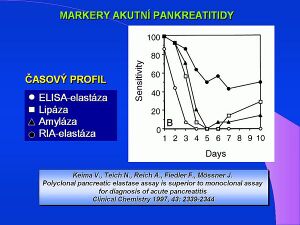Amylase / interpretation
< Amylase
Elevated levels of total α-amylase activity are evident in a number of diseases. The most common diagnostic reason is suspected acute pancreatitis. Although the level of total α-amylase is increased in 100% of acute pancreatitis, it is also increased in 80% of all cases of acute abdominal pain. The determination of the pancreatic isoenzyme α-amylase (β-amylase) has a significantly greater diagnostic benefit, the level of which is also increased in 100% of cases of acute pancreatitis, and is only increased in 10% of acute abdominal pain. In routine clinical practice, the criterion of a five-fold increase in total amylase is used, which is a diagnostic indicator of acute pancreatitis. Elevated serum levels are, of course, demonstrable in both acute and chronic kidney diseases, in intestinal inflammations in 30% of cases of acute appendicitis. The increase in urinary α-amylase levels in acute pancreatitis persists longer and occurs later than the increase in serum levels. The salivary type of α-amylase (S-amylase) is increased in diseases of the salivary glands, in some lung diseases, in a number of malignant tumors, ovarian cysts, ectopic pregnancy. Normal values of the ratio of amylase to creatinine clearance are between 2-4%, in pancreatitis the index rises to 10%. An increased amylase / creatinine clearance index has been demonstrated, for example, in diabetic ketoacidosis, burns, myeloma and renal disorders. Decreased clearance index is diagnostically significant for macroamylasemia.
There are also specific methods for the determination of salivary α-amylase, such as monoclonal antibody ELISA.
Links[edit | edit source]
Related articles[edit | edit source]
Source[edit | edit source]
- with the permission of the author taken from KOCNA, Petr. GastroLab: MiniEncyclopedia of laboratory methods in gastroenterology [online]. © 2002. Last revision 2011-01-08, [cit. 2011-03-04]. <http://www1.lf1.cuni.cz/~kocna/glab/glency1.htm>.

